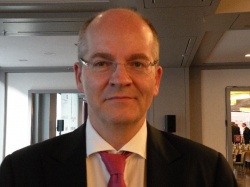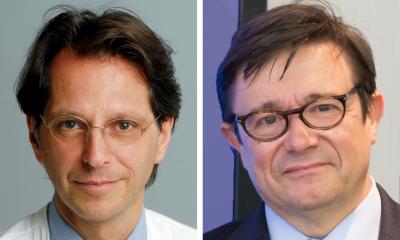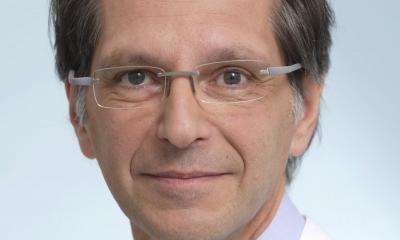Reasonable complements in cancer therapy
Interventional and endoscopic procedures become realistic options
Until now, interventional and endoscopic therapies have held little importance in common cancer treatment. However, given the trend towards personalised medicine and targeted cancer therapy, increasing attention is being paid to reasonable complements to traditional cancer surgery.


During the 1st European Forum on Oncology, renowned experts Professor Thomas Vogl and Professor Alexander Meining discussed the potentials and limitations of interventional radiology and endoscopic treatment.
‘Interventional radiology procedures are a reasonable option particularly for the treatment of unresectable hepatic tumours and metastases,’ explained Prof. Vogl, Director of Institute of Diagnostic and Interventional Radiology at the University Hospital Frankfurt, Germany. ‘A survival up to five years can be proven in patients with unresectable liver metastases after thermal ablation,’ he said, then quoting a six-year study (ending 12/2009), which examined the survival rate of patients with liver metastases after a laser-induced thermotherapy (LITT). On average patients treated with curative intention survived 4.2 years and patients treated with palliative intention 3.1 years. The rates of complications and recurrence, he emphasised, are moderate. ‘In lesions up to 4 cm the recurrence rate is around 2-3%. Almost every procedure nowadays achieves this rate.’
Whether hepatic ablation or hepatic resection is favourable is frequently questioned by surgeons, radiologists and colleagues within the interventional discipline, because randomised studies are lacking that prove the best therapy for patients, particularly those with tumours and metastases less than or equal to 5 cm, he explained. According to one survey (Isbert, Gemer et al. British Journal of Surgery 2002; 89:1252-1259) hepatic ablation delays and reduces residual intrahepatic tumour growth and macroscopic peritoneal tumour spread in comparison to hepatic resection, he said.
Therefore, an ablation seems favourable. Prof. Vogl promotes an interventional therapy strategy for liver metastases in a third-line protocol. He himself favours a neo-adjuvant chemo-embolisation or perfusion and a response LITT- or RFA-therapy for less than or equal to five metastases with a diameter of less than or equal to 5 cm. For bigger size metastases (≤ 8 cm) he proposes a palliative chemo-embolisation or perfusion and a response therapy with LITT or RFA. Multiple tumours should be treated by symptomatic chemo-embolisation or perfusion if all systemic chemotherapy protocols failed.
Considerably more vexing is the question of when interventional treatment is indicated in lung cancer or metastases. According to Prof. Vogl, the crucial question is whether resection or thermal ablation is indicated and, in consequence, if a combination of chemo- or autoimmune therapy should be considered. Although he quoted encouraging results of thermal ablation, he called for evidence-based studies in general and a genuine study that compares thermal ablation with stereotactic radiotherapy, to ascertain the best therapy.
Endoscopic cancer therapies appear to be a reasonable alternative to treat gastrointestinal neoplasia, as Professor Alexander Meining, Head of Endoscopy division of Klinikum rechts der Isar, Munich, suggested: ‘Endoscopic cancer therapy is feasible and, under the right preconditions, surgical standards can be achieved.’ This method, he added, is also the cheapest solution with minimal invasiveness.
The basic prerequisite for successful endoscopic cancer therapy is to determine the risk of lymph node metastasis (LNM). The risk differs in relation to location and depths of tumour infiltration. Prof. Meining quoted several studies that prove no risk if only the mucosa is infiltrated. An exception has to be seen in the treatment of oesophagus squamous, where an incidence of LNM from 0-5% seems possible. When the upper third of submucosa is affected (500 um), the incidence of LNM rises from 2-7%, except for the colon, where no risk could be proved. Hence submucosal invasive carcinoma can also be removed almost safely by endoscopic therapy. Whereas revision surgery appears to be necessary if the oesophagus is affected by submucosal invasive carcinoma.
In endoscopic cancer therapy three different methods are used -- endoscopic mucosal resection (EMR), endoscopic submucosal dissection (ESD) and the rather rarely used endoscopic mucosal ablation (EMA) – but particularly used for high-grade dysplasia or Barrett’s oesophagus cancer.
The method of choice depends on location, endoscopic and histological criteria. Compared with ESD, EMR is faster (about 10 minutes), safer and relatively simpler. However, the disadvantages are not insignificant: EMR is limited to smaller lesions (smaller than or equal to 20 mm) and there is a higher risk of recurrence (around 20%). Nonetheless, ESD remains more difficult to handle, takes more time (about 60 minutes) and has a higher complication rate. The risk of perforation of 5-10% is particularly significant when compared with standard EMR.
In conclusion, Prof. Meining called for further technical innovations to enable a simpler, quicker and therefore widely available endoscopic therapy.
29.12.2010











